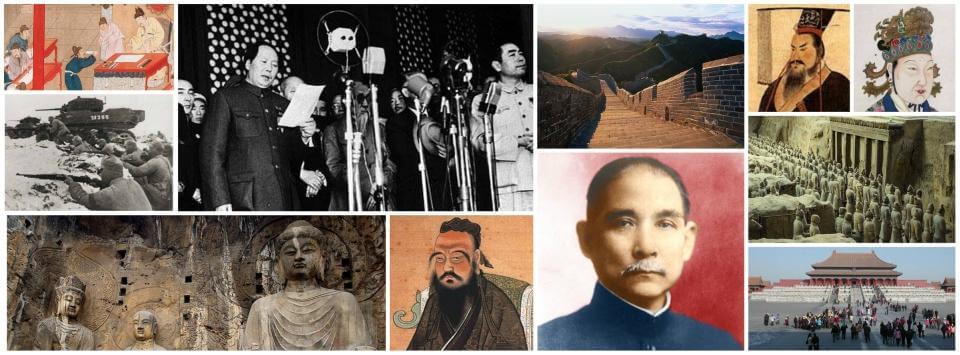
Sui Dynasty (AD 589 – 618)
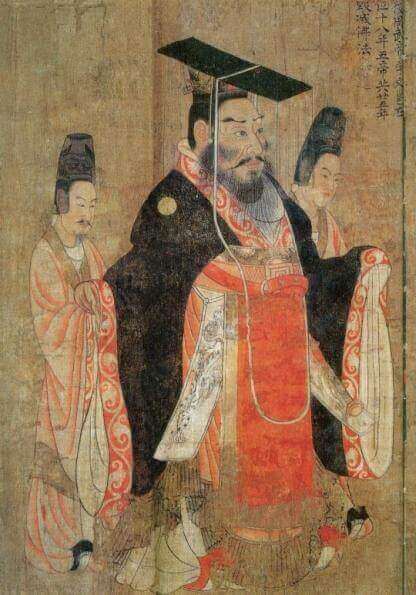 Yuwen Yong alias Emperor Wu, the Emperor of Northern Zhou (Tang dynasty painting by Yan Liben)The process of eventual Chinese reunification was already set in motion in AD 577, when the Northern Zhou state (AD 557 - 581) defeated and incorporated the Northern Qi state (AD 550 - 577). Both states had been indirect successors of the Tuoba Wei Dynasty. However, the Northern Zhou's capable Emperor Wu died just a year later and was succeeded by his incompetent son, who reigned for only two years until his death as Emperor Xuan.
Yuwen Yong alias Emperor Wu, the Emperor of Northern Zhou (Tang dynasty painting by Yan Liben)The process of eventual Chinese reunification was already set in motion in AD 577, when the Northern Zhou state (AD 557 - 581) defeated and incorporated the Northern Qi state (AD 550 - 577). Both states had been indirect successors of the Tuoba Wei Dynasty. However, the Northern Zhou's capable Emperor Wu died just a year later and was succeeded by his incompetent son, who reigned for only two years until his death as Emperor Xuan.
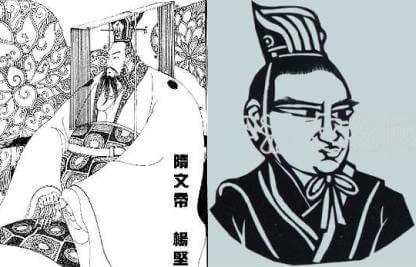 Left: Emperor Xuan of Northern Zhou Right: Emperor Jing of Northern ZhouThe Sino-Turkic military general Yang Jian (AD 541 - 604) from the Sui home district of the Northern Zhou state then effectively seized power as the regent of the succeeding child Emperor Jing (Emperor Xuan's son). However, Yang Jian convinced the child emperor to abdicate the throne to him in AD 581. He then proclaimed the Sui Dynasty (AD 581 - 618) which he ruled as Emperor Wen.
Left: Emperor Xuan of Northern Zhou Right: Emperor Jing of Northern ZhouThe Sino-Turkic military general Yang Jian (AD 541 - 604) from the Sui home district of the Northern Zhou state then effectively seized power as the regent of the succeeding child Emperor Jing (Emperor Xuan's son). However, Yang Jian convinced the child emperor to abdicate the throne to him in AD 581. He then proclaimed the Sui Dynasty (AD 581 - 618) which he ruled as Emperor Wen.
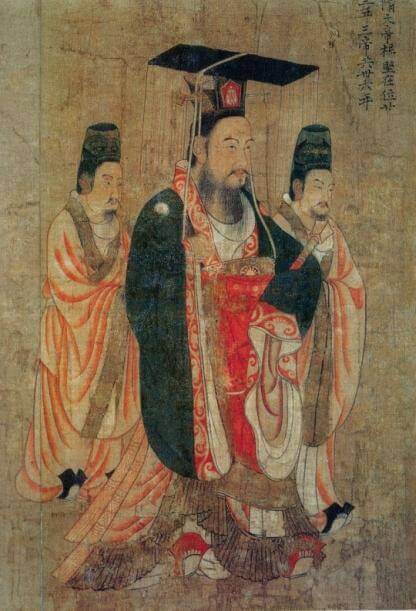 Yang Jian, the founding Emperor Wen of Sui (Tang dynasty painting by Yan Liben)During the next eight years, Emperor Wen pursued his goal of unifying China through military action and cunning diplomacy. At first, the nascent Sui empire solidified its dominating position in China's north by eliminating rivals militarily or creating dissension within their ranks.
Yang Jian, the founding Emperor Wen of Sui (Tang dynasty painting by Yan Liben)During the next eight years, Emperor Wen pursued his goal of unifying China through military action and cunning diplomacy. At first, the nascent Sui empire solidified its dominating position in China's north by eliminating rivals militarily or creating dissension within their ranks.
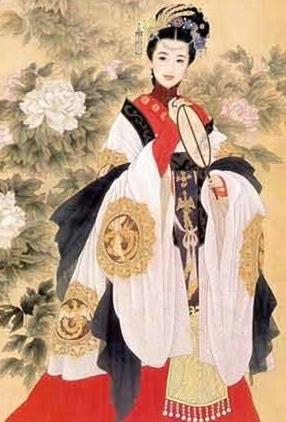 Empress Xiao, wife of Emperor Wen's son Yang GuangThe former Northern Dynasties were thereby unified. In AD 582, Emperor Wen's son Yang Guang married a princess (later known as Empress Xiao) of the vassal Western Liang state, securing the alliance between Sui and Western Liang.
Empress Xiao, wife of Emperor Wen's son Yang GuangThe former Northern Dynasties were thereby unified. In AD 582, Emperor Wen's son Yang Guang married a princess (later known as Empress Xiao) of the vassal Western Liang state, securing the alliance between Sui and Western Liang.
Decisive military action against the southern Chen state (the last of the four states that had succeeded one another as the Southern Dynasties) required careful preparation.
The Sui state prepared by building up the strength of its military over several years and by using propaganda that placed a lot of emphasis on both states' shared adherence to the Buddhist religion (religious differences between North and South were already minimal then). By using Buddhism as a way to win sympathizers in the South, the questionable feasibility of a true North - South reunification of the Chinese people, based on the astonishing differences in literary traditions between North and South (explained in the preceding chapter), was sublimely brushed aside.
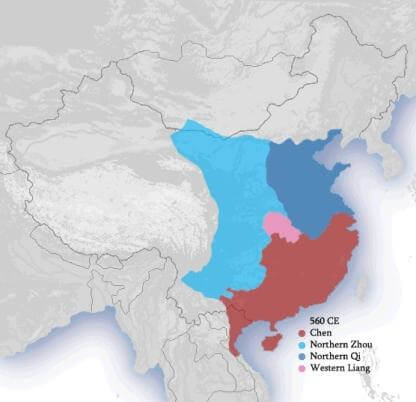 Map of the Northern and Southern Dynasties in AD 560When the time for military action came in AD 589, the Chen state didn't put up much resistance and China was unified once again under the Sui dynasty. Emperor Wen and his son Yang Guang, hoping to solidify their new empire, then established a new institutional/administrative order and political structure that, though not prolonging the short-lived Sui dynasty, set the right conditions for the flourishing of the next dynasty - the Tang dynasty.
Map of the Northern and Southern Dynasties in AD 560When the time for military action came in AD 589, the Chen state didn't put up much resistance and China was unified once again under the Sui dynasty. Emperor Wen and his son Yang Guang, hoping to solidify their new empire, then established a new institutional/administrative order and political structure that, though not prolonging the short-lived Sui dynasty, set the right conditions for the flourishing of the next dynasty - the Tang dynasty.
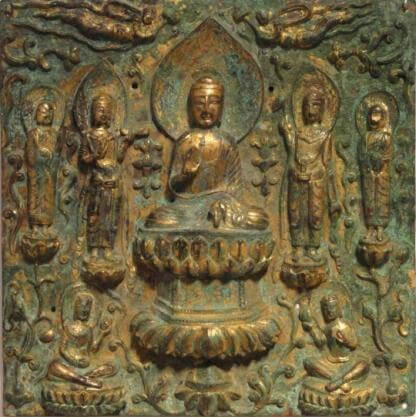 Bronze plaque from the Sui dynasty showing a seated Buddha, Bodhisattvas and monksTheir new legal code was an amalgamation of laws from different dynastic states in north and south and was meant to regulate both government and everyday affairs of ordinary citizens. Learning from the mistakes of past rulers that often had to contend with rebellions of landless peasants, Emperor Wen and Yang Guang further set about creating a new land distribution system - the so-called "equal - field" system - that ensured access (not necessarily equal) of all the peasantry to tracts of farmland.
Bronze plaque from the Sui dynasty showing a seated Buddha, Bodhisattvas and monksTheir new legal code was an amalgamation of laws from different dynastic states in north and south and was meant to regulate both government and everyday affairs of ordinary citizens. Learning from the mistakes of past rulers that often had to contend with rebellions of landless peasants, Emperor Wen and Yang Guang further set about creating a new land distribution system - the so-called "equal - field" system - that ensured access (not necessarily equal) of all the peasantry to tracts of farmland.
Under this system, the assigned land was partially redistributed after the death of its owner to ensure both that no peasants remained completely without land and that no individual landowners could amass undue amounts of land. However, the vast tracts of land that the new aristocratic class had begun to amass during the Later Han dynasty was not affected by this system of redistribution and they retained their land holdings in their entirety.
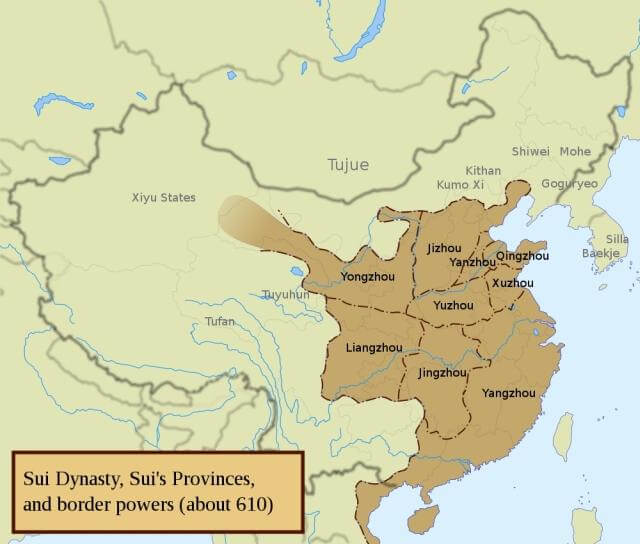 Map of the Sui dynasty state around AD 610
Map of the Sui dynasty state around AD 610
Furthermore, recognizing the continuing threat of invasion from forces outside of China (especially near its northwestern border), the Sui rulers established agricultural colonies of soldiers in these border areas. That had the advantage that in case of an invasion, the defending troops were already located in the danger areas, where they sustained themselves through their own agricultural work.
 Chinese swords from the Sui Dynasty, found near Luoyang
Chinese swords from the Sui Dynasty, found near Luoyang
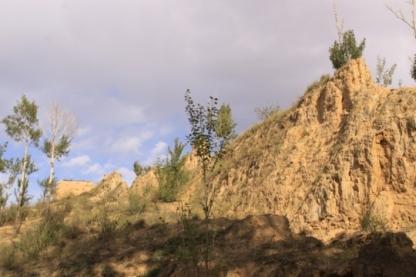 remnants of the Great Wall near Yulin, Shaanxi provinceTo further secure the Sui dynasty's territory from incursions by nomadic tribes, vast new sections of the Great Wall were built in China's North and Northwest. Some of these construction projects occupied more than one million workers. Major repair work of the sections built during earlier times (the Qin and Han dynasty) was undertaken as well.
remnants of the Great Wall near Yulin, Shaanxi provinceTo further secure the Sui dynasty's territory from incursions by nomadic tribes, vast new sections of the Great Wall were built in China's North and Northwest. Some of these construction projects occupied more than one million workers. Major repair work of the sections built during earlier times (the Qin and Han dynasty) was undertaken as well.
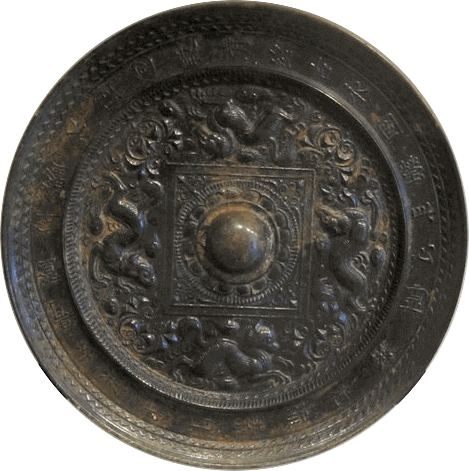 Sui dynasty bronze mirror
Finally, a system of public granaries was established during the Sui dynasty. In this system the government purchased surplus grain during harvest time at subsidized prices and stored it in these public granaries. In case of rising commodity prices (due to bad harvests, floods), the government then sold the surplus grain and thereby helped to lower and stabilize prices again.
Sui dynasty bronze mirror
Finally, a system of public granaries was established during the Sui dynasty. In this system the government purchased surplus grain during harvest time at subsidized prices and stored it in these public granaries. In case of rising commodity prices (due to bad harvests, floods), the government then sold the surplus grain and thereby helped to lower and stabilize prices again.
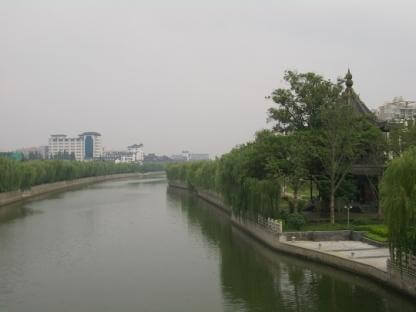 old channel of the historic Grand Canal near Yangzhou's historical centerAfter Emperor Wen's death, his son Yang Guang succeeded him as Emperor Yang of Sui and continued the efforts to strengthen the empire. Even though his military expedition to invade the Korean peninsula was a failure, his troops managed to push back the threatening Turkic nomads in the Northwest. However, these military expeditions drained the country's financial and material resources considerably and the empire lost a large number of soldiers, all of which began to stir up resentment and unrest among large parts of the population.
old channel of the historic Grand Canal near Yangzhou's historical centerAfter Emperor Wen's death, his son Yang Guang succeeded him as Emperor Yang of Sui and continued the efforts to strengthen the empire. Even though his military expedition to invade the Korean peninsula was a failure, his troops managed to push back the threatening Turkic nomads in the Northwest. However, these military expeditions drained the country's financial and material resources considerably and the empire lost a large number of soldiers, all of which began to stir up resentment and unrest among large parts of the population.
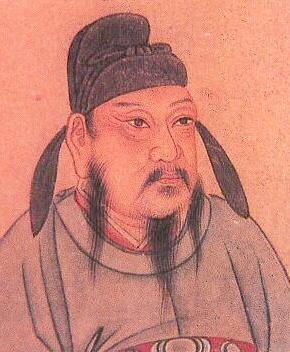 Li Yuan, the founding Emperor Gaozu of the Tang dynastyDuring Emperor Yang's leadership, work on a number of water canals (that would later be known as the Grand Canal) that would carry grain from the mouth of the Yangtze River to the poorer Northwest was started. Due to climate change, the now hotter and drier Northwest was struggling to produce enough grain to feed the growing population. Even though the construction of the Grand Canal is now regarded favourably, it was not a popular measure at the time, especially among the population that was displaced because of it.
Li Yuan, the founding Emperor Gaozu of the Tang dynastyDuring Emperor Yang's leadership, work on a number of water canals (that would later be known as the Grand Canal) that would carry grain from the mouth of the Yangtze River to the poorer Northwest was started. Due to climate change, the now hotter and drier Northwest was struggling to produce enough grain to feed the growing population. Even though the construction of the Grand Canal is now regarded favourably, it was not a popular measure at the time, especially among the population that was displaced because of it.
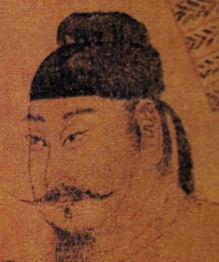 Li Yuan's son Li Shimin, who later became Emperor TaizongRising anger among the oppressed population about these public works projects and military campaigns led to an increasing number of rebellions in large parts of the empire. That was one factor in the demise of the Sui dynasty by AD 618. Another important but odd factor was a series of rumours regarding certain mystical events that began to circulate among the population of the Sui capital in Chang'an in the preceding years. A rumour began to spread (first through soothsayers, later through a popular song) that a person with the family name Li would ascend the throne.
Li Yuan's son Li Shimin, who later became Emperor TaizongRising anger among the oppressed population about these public works projects and military campaigns led to an increasing number of rebellions in large parts of the empire. That was one factor in the demise of the Sui dynasty by AD 618. Another important but odd factor was a series of rumours regarding certain mystical events that began to circulate among the population of the Sui capital in Chang'an in the preceding years. A rumour began to spread (first through soothsayers, later through a popular song) that a person with the family name Li would ascend the throne.
Naturally, Emperor Yang wasn't pleased about this and in his efforts to protect the throne for the Yang family began to discredit and eliminate a number of officials and otherwise influential people surnamed Li. Li Yuan (AD 566 - 635), the commander of the military garrison in Taiyuan north of Chang'an, was one such leader who felt threatened by Emperor Yang's intrigues against people named Li and was motivated by his ambitious son Li Shimin (AD 598 - 649) to strike preemptively.
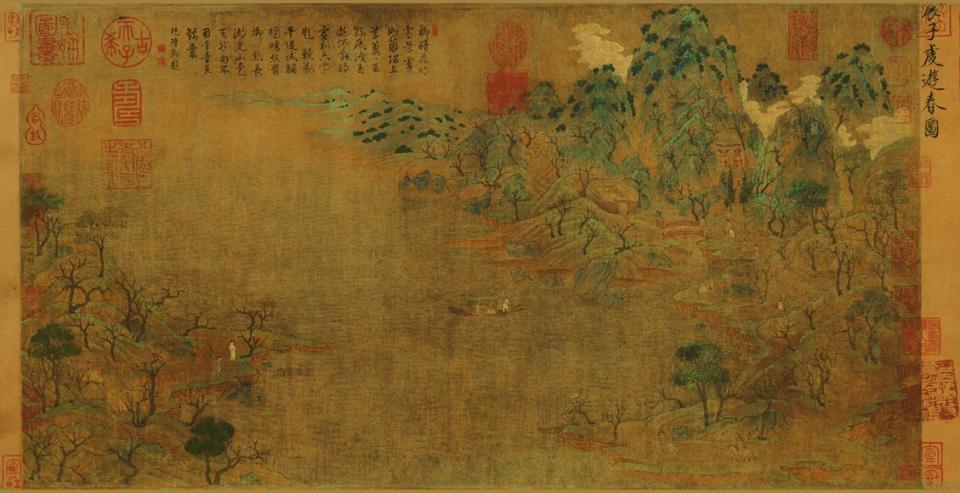 Zhan Ziqian's painting "Strolling About in Spring", the oldest surviving Chinese landscape painting
Zhan Ziqian's painting "Strolling About in Spring", the oldest surviving Chinese landscape painting
Chinese History Digest's summary continues with the Tang dynasty, one of the most prosperous periods in China's history.

